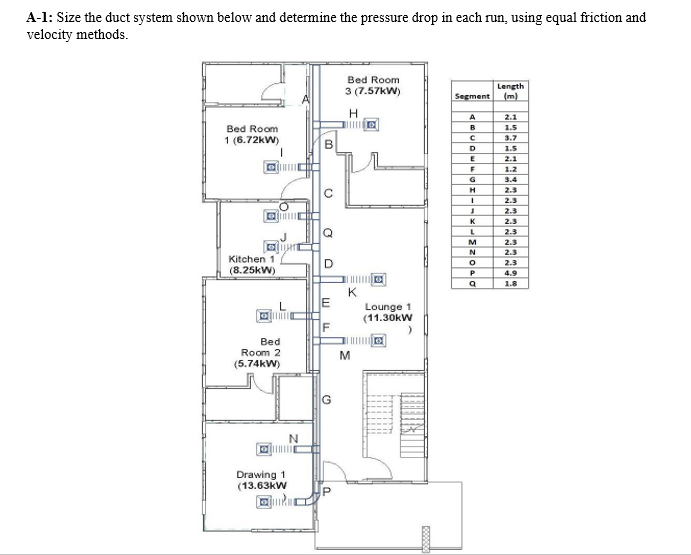Aspect ratio Supply temperature | Pressure drop per unit length | Main and branch đuct velocities for equal friction method for velocity method 5 m/s, 3 m/s (***) The loss coefficients are: Entrance (0.75), Tee (branch) 1.2, Tee (through) 0.3, Wye (branch) 0.4, Elbow (900) 0.25. Each of the outlets has a pressure drop of 5 Pa and is attached using a 900 down elbow. A-2: Select insulation for the duct which is suitable for use in HVAC systems. A-3: Describe how you would calculate the duct heat gain by applying your knowledge of heat transfer. You are not required to perform any calculations. Note: You may assume suitable values, where required, with proper justification and reference. 21 160C 0.7 Pa/m
Aspect ratio Supply temperature | Pressure drop per unit length | Main and branch đuct velocities for equal friction method for velocity method 5 m/s, 3 m/s (***) The loss coefficients are: Entrance (0.75), Tee (branch) 1.2, Tee (through) 0.3, Wye (branch) 0.4, Elbow (900) 0.25. Each of the outlets has a pressure drop of 5 Pa and is attached using a 900 down elbow. A-2: Select insulation for the duct which is suitable for use in HVAC systems. A-3: Describe how you would calculate the duct heat gain by applying your knowledge of heat transfer. You are not required to perform any calculations. Note: You may assume suitable values, where required, with proper justification and reference. 21 160C 0.7 Pa/m
Elements Of Electromagnetics
7th Edition
ISBN:9780190698614
Author:Sadiku, Matthew N. O.
Publisher:Sadiku, Matthew N. O.
ChapterMA: Math Assessment
Section: Chapter Questions
Problem 1.1MA
Related questions
Question

Transcribed Image Text:A-1: Size the duct system shown below and determine the pressure drop in each run, using equal friction and
velocity methods.
Bed Room
Length
(m)
3 (7.57kW)
Segment
A
2.1
Bed Room
B
1.5
1 (6.72kW)
3.7
D
1.5
2.1
1.2
3.4
2.3
C
2.3
2.3
K
2.3
Q
2.3
M
2.3
2.3
Kitchen 1
(8.25kW)
2.3
4.9
1.8
K
E
Lounge 1
(11.30kW
Bed
II E
Room 2
(5.74kW)
G
Drawing 1
(13.63kW

Transcribed Image Text:Aspect ratio Supply temperature Pressure drop per unit length Main and branch duct velocities
for equal friction method
for velocity method
(***)
160C
0.7 Pa/m
5 m/s, 3 m/s
The loss coefficients are: Entrance (0.75), Tee (branch) 1.2, Tee (through) 0.3, Wye (branch) 0.4, Elbow
(900) 0.25. Each of the outlets has a pressure drop of 5 Pa and is attached using a 900 down elbow. A-2:
Select insulation for the duct which is suitable for use in HVAC systems. A-3: Describe how you would
calculate the duct heat gain by applying your knowledge of heat transfer. You are not required to perform
any calculations. Note: You may assume suitable values, where required, with proper justification and
reference.
Expert Solution
This question has been solved!
Explore an expertly crafted, step-by-step solution for a thorough understanding of key concepts.
Step by step
Solved in 2 steps

Recommended textbooks for you

Elements Of Electromagnetics
Mechanical Engineering
ISBN:
9780190698614
Author:
Sadiku, Matthew N. O.
Publisher:
Oxford University Press

Mechanics of Materials (10th Edition)
Mechanical Engineering
ISBN:
9780134319650
Author:
Russell C. Hibbeler
Publisher:
PEARSON

Thermodynamics: An Engineering Approach
Mechanical Engineering
ISBN:
9781259822674
Author:
Yunus A. Cengel Dr., Michael A. Boles
Publisher:
McGraw-Hill Education

Elements Of Electromagnetics
Mechanical Engineering
ISBN:
9780190698614
Author:
Sadiku, Matthew N. O.
Publisher:
Oxford University Press

Mechanics of Materials (10th Edition)
Mechanical Engineering
ISBN:
9780134319650
Author:
Russell C. Hibbeler
Publisher:
PEARSON

Thermodynamics: An Engineering Approach
Mechanical Engineering
ISBN:
9781259822674
Author:
Yunus A. Cengel Dr., Michael A. Boles
Publisher:
McGraw-Hill Education

Control Systems Engineering
Mechanical Engineering
ISBN:
9781118170519
Author:
Norman S. Nise
Publisher:
WILEY

Mechanics of Materials (MindTap Course List)
Mechanical Engineering
ISBN:
9781337093347
Author:
Barry J. Goodno, James M. Gere
Publisher:
Cengage Learning

Engineering Mechanics: Statics
Mechanical Engineering
ISBN:
9781118807330
Author:
James L. Meriam, L. G. Kraige, J. N. Bolton
Publisher:
WILEY